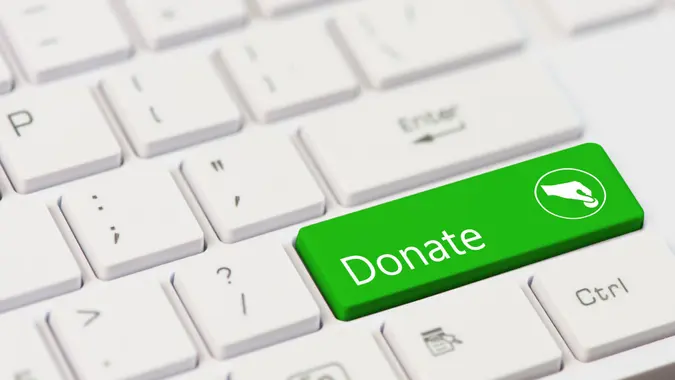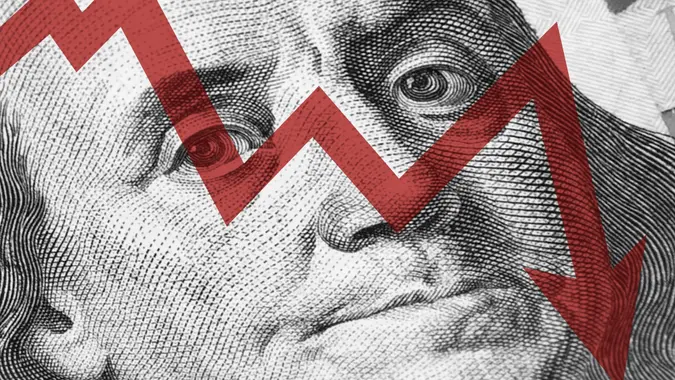The No. 1 Money Problem You Should Be Worried About (And No, It’s Not Inflation)

Commitment to Our Readers
GOBankingRates' editorial team is committed to bringing you unbiased reviews and information. We use data-driven methodologies to evaluate financial products and services - our reviews and ratings are not influenced by advertisers. You can read more about our editorial guidelines and our products and services review methodology.

20 Years
Helping You Live Richer

Reviewed
by Experts

Trusted by
Millions of Readers
With everything happening in the economy lately, inflation is almost definitely on your radar, but you might not be aware of stagflation. In a recent TikTok, “Your Rich BFF” Vivian Tu highlighted this financial concept and why you need to know about it.
Referring to stagflation as “inflation’s scary older brother,” Tu said you need to understand how this concept works if you want to be prepared for a recession.
What Is Stagflation?
Tu listed the “three ingredients in a stagflation cocktail”: high inflation, a stagnant economy and high unemployment.
Sarah Maitre, CFA, CFP, founder and financial planner at Camriel Advisors, added that stagflation occurs when the economy slows down, but prices keep rising.
“It’s one of the worst combos out there, because your paycheck doesn’t go as far, and you’re not likely to get a raise to keep up,” she said. “We haven’t seen full-blown stagflation in decades — the 1970s were the last major example — but there are signs we could be heading in that direction.”
Stagflation and the Current Economy
Although President Donald Trump’s high tariffs have been declared unlawful by the Court of International Trade — judges said the president does not have the authority to impose tariffs; that is a power of Congress — the trade war may still just be beginning, and it’s unclear how other countries will respond. The long-term economic effects have yet to be seen.
Before the court ruling, companies were warning consumers about price increases due to the tariffs.
“Walmart, for example, said it [expected] to raise prices, which sparked backlash from Trump, who thinks businesses should absorb the costs,” Maitre said. “But for a lot of companies, that’s just not realistic.”
If businesses are already operating on tight margins, she said the extra costs will likely be absorbed by consumers. The Trump administration is already pushing back in an attempt to impose the tariffs, The Wall Street Journal reported, but it is unclear now as to what they will look like, in the end.
As for economic growth, Maitre said the outlook is currently bleak.
“Job creation has slowed, and unless we see a big push to build or produce more here at home, that probably won’t change,” she said. “Some global investors are also pulling money out of the U.S., which adds even more uncertainty.”
Pay Attention — But Don’t Panic
If you’re starting to panic, try to remain calm. While Mark Stancato, CFP, EA, ECA, CRPS, founder and lead advisor at VIP Wealth Advisors, said you should pay attention to stagflation — even more than inflation — he advised against making decisions based on sensational headlines.
“There’s a lot of buzz right now about stagflation, and, like most trending financial content, it’s being packaged for clicks rather than clarity,” he said.
Tips To Protect Yourself From Stagflation
If stagflation happens, it’s important to be ready for it. Maitre and Stancato offered the following advice to prepare your finances.
Hold Real Liquidity
Put six to 12 months of living expenses in a high-yield savings account or short-term treasuries, Stancato said. This can provide you with cash if your income isn’t increasing with rising prices.
Diversify Into Real Assets
“Real estate, commodities and infrastructure tend to retain value better when traditional equities and bonds are under pressure,” Stancato said. “Avoid floating-rate debt [and] lock in fixed rates wherever possible.”
He said stagflation isn’t a good match for variable interest rates.
Tighten Up Your Spending
Now is the time to create extra room in your budget, Maitre said. Closely examine your variable spending and find ways to cut costs.
Boost Your Emergency Fund
You might think your emergency fund is solid, but the potential onset of stagflation could be a good reason to bulk it up.
“Prices are likely to be higher in an emergency, too,” Maitre said. “While three to six months of expenses is the general rule of thumb, it doesn’t hurt to aim for more right now.”
Review Your Investments
It’s a good idea to check your portfolio to make sure it’s able to handle any turmoil caused by potential stagflation, Maitre said. Investing in assets like divided-paying stocks and Treasury Inflation-Protected Securities (TIPS) can be wise, as they tend to hold up better in inflationary environments, she added.
Editor’s note on political coverage: GOBankingRates is nonpartisan and strives to cover all aspects of the economy objectively and present balanced reports on politically focused finance stories. You can find more coverage of this topic on GOBankingRates.com.
More From GOBankingRates
- Nearly 1 in 3 Americans Hit by a Costly Holiday Scam, Norton Survey Shows -- How To Avoid This
- Here's What Retirees Wasted the Most Money On in 2025 -- and How To Avoid It in 2026
- How Middle-Class Earners Are Quietly Becoming Millionaires -- and How You Can, Too
- 6 Safe Accounts Proven to Grow Your Money Up to 13x Faster
 Written by
Written by  Edited by
Edited by 

























